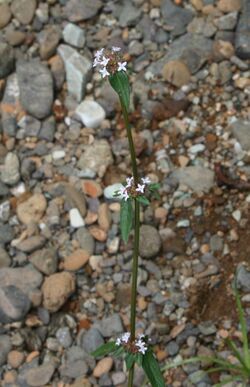Biology:Spermacoce remota
| Woodland false buttonweed | |
|---|---|

| |
| Scientific classification | |
| Kingdom: | Plantae |
| Clade: | Tracheophytes |
| Clade: | Angiosperms |
| Clade: | Eudicots |
| Clade: | Asterids |
| Order: | Gentianales |
| Family: | Rubiaceae |
| Subfamily: | Rubioideae |
| Tribe: | Spermacoceae |
| Genus: | Spermacoce |
| Species: | S. remota
|
| Binomial name | |
| Spermacoce remota Lam.
| |
| Synonyms[2] | |
| |
Spermacoce remota, the woodland false buttonweed,[3] is a species of plant in the Rubiaceae.[4] It is native to the southeastern United States (Texas , Florida, Georgia, Alabama), West Indies (Bermuda, Bahamas, Hispaniola, Puerto Rico, the Cayman Islands, Trinidad, Lesser Antilles, etc.), Mexico, Central America and South America. It is naturalized in Taiwan, Southeast Asia (Thailand, Vietnam, Malaysia, Indonesia), China (Guangdong), India , Sri Lanka, New Guinea, Mauritius and many other oceanic islands (including Hawaii and the Galápagos).[2]
Spermacoce remota is a perennial herb or sub-shrub up to 70 cm tall. Stems are either round or square in cross-section. Leaves are lanceolate, up to 5 cm long. Flowers are small, white, in a clump at the top of the stem.[5] This herb is a common ground for oviposition of butterfly eggs, such as those of Anartia fatima.
References
- ↑ Bárrios, S.; Copeland, A. (2021). "Spermacoce remota". IUCN Red List of Threatened Species 2021: e.T192157064A192157066. doi:10.2305/IUCN.UK.2021-3.RLTS.T192157064A192157066.en. https://www.iucnredlist.org/species/192157064/192157066. Retrieved 2 November 2022.
- ↑ 2.0 2.1 Kew World Checklist of Selected Plant Families, Spermacoce remota
- ↑ "Spermacoce assurgens". Natural Resources Conservation Service PLANTS Database. USDA. https://plants.usda.gov/core/profile?symbol=SPAS2. Retrieved 25 November 2015.
- ↑ Lamarck, J.B.A.P. de Monnet de in Lamarck, J.B.A.P. de Monnet de & Poiret, J.L.M. (1791) Tableau Encyclopedique et Methodique 1(1): 273
- ↑ Flora of China, v 19 p 329, 光叶丰花草 guang ye feng hua cao, Spermacoce remota
External links
- Atlas of Florida Vascular Plants Spermacoce remota
- Nature Love You (Singapore), Spermacoce remota
- Australian Tropical Rainforest Plants, Spermacoce remota
- Pacific Island Ecosystems at Risk,Spermacoce remota
- Encyclopedia of Life Spermacoce remota
- Landscape Plants for South Florida Spermacoce remota
Wikidata ☰ Q15453438 entry
 |


